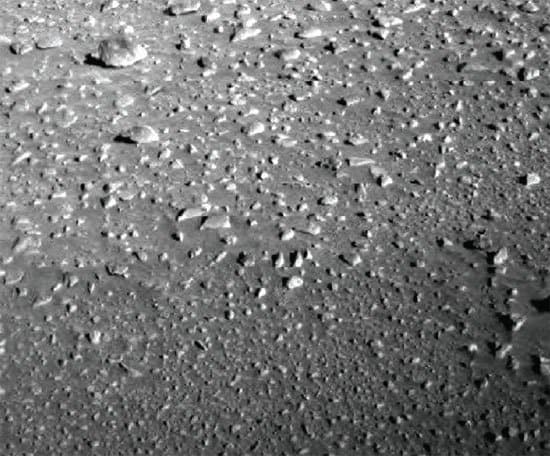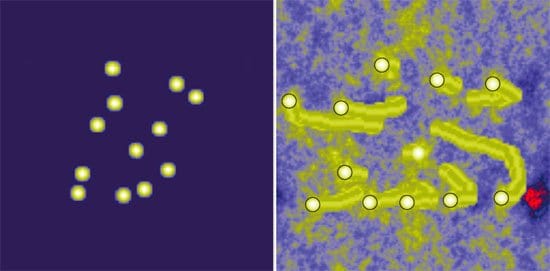
Can you spot the pattern in this photo of Martian rocks? If not, then don’t feel bad: according to researchers in the US and Canada the very lack of a pattern means that there must be some mechanism driving the rocks that way. Studying this process, in which built-up sand levers rocks away from one another, could help geophysicists to understand how climate has steadily transformed the surface of the red planet.
“Rather than look at patterns on the Martian surface, we were looking at a pronounced absence of any patterns at some sites,” Andrew Leier of the University of Calgary, Canada, told physicsworld.com. “We had noticed similar features in desert settings on Earth and tried to understand how this distribution came about.”
The photograph above and others like it come from NASA’s Spirit Rover, which touched down on the red planet at the beginning of 2004. When other geophysicists first saw the pictures, there was an idea that the even distribution could have emerged during intense bouts of wind in order to minimize air drag. However, there has been little lab evidence to suggest that an even distribution would improve aerodynamics and, moreover, shifting just small rocks would take winds speeds of hundreds of kilometres per hour.
“We’re not saying that the idea is wrong,” says group leader Jon Pelletier of the University of Arizona in Tuscon, US, “just that there is a simpler explanation.”
Mounds of dust
Pelletier and colleagues sketched out their mechanism while performing experiments in a wind tunnel containing a Mars-like surface. They found that the wind throws up dust and sand, which gradually accumulates behind a rock. When the mound becomes big enough, the rock rolls forwards.
But the effect is not be the same for all rocks. Those within a group are better shielded from the wind, and the mound forms to one side, so that the rock falls sideways. In this way the rocks “repel” one another, and the group spreads out (Geology 37 55).
“You could probably see it happen if you were looking for it, say, in a desert during an extreme windstorm,” says Pelletier. But, he adds, the growth of plants and the contraction of the surface due to moisture would often disguise the effect before it has a chance to alter the rock distribution visibly.
After the wind tunnel experiments, Pelletier’s group designed a computer simulation to study the mechanism in more detail (see figure). Based on a well-known model of the migration of sand dunes, it focused on three key aspects: how airflow generates a shearing force on the rocks’ surface; how this force affects the movement of sand; and the critical angle when the rocks topple.
The researchers found that the critical angle greatly affects the rock migration, indicating that larger rocks or those that are more angular will not so readily demonstrate the effect.
The rocky road
Pelletier explains that although his group’s work does not tell us anything “fundamental” about the wind in Martian climate, it does show how Mars’s landscape has evolved and how rocks of different shapes and sizes co-exist on a surface.
“Mars is a nice place to isolate the effect,” he says, adding that his type of work has only been possible in the few years since Spirit landed. “We spend a great deal of effort trying to get images of rocks on sand, and I just want to understand what’s going on.”




